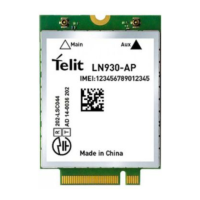LN930 M.2 Hardware User Guide
1VV0301078 Rev.10 – 2015-11-11
Reproduction forbidden without written authorization from Telit Communications S.p.A. - All Rights Reserved. Page 32 of 88
Table 8 X-GOLD™ Baseband to GNSS Interface Signals
1.8 V Supply provided from X-GOLD™ Baseband
The data and control I/F between the X-GOLD™ baseband and the GNSS
device is over a 4 wire UART interface which include CTS/RTS handshaking.
X-GOLD™ baseband uses this signal to control Power-on/reset of the GNSS
device
X-GOLD™ baseband provides a permanently active 32 kHz clock to the GNSS
device
X-GOLD™ baseband provides a 26 MHz clock to the GNSS device for
frequency aiding.
X-GOLD™ baseband provides this signal to notify the GNSS device of that
GSM Tx activity (PA Blanking)
X-GOLD™ baseband provides a strobe signal to the GNSS device to allow fine
time assistance based on 3GPP cell timing.
The GNSS signals available to the host at the WWAN module interface to support
GNSS operation are shown in
Table 9
.
Table 9
GNSS Module Interface Signals
I2C IRQ - Interrupt signal
TX Blanking – Active High when M.2 is
transmitting.
• High: GNSS function is determine by AT
command.
• Low: GNSS function is disabled.
• GNSS_DISABLE# pin has a pull-up resistor
The system control interface is used to control the power-up and reset of the WWAN
module. There are additional control signals to disable the radio, drive an LED as a status
indicator, an output to wake the host processor, and an input for body SAR.

